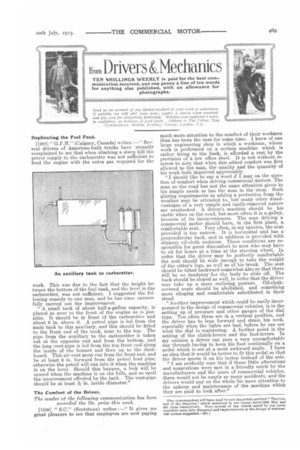hm Drivers &Mechanics
Page 31

If you've noticed an error in this article please click here to report it so we can fix it.
TEN SHILLINGS WEEKLY is paid for the best communication received, and one penny a line of ten words for anything else published, with an allowance for photographs.
Send us an account of any sPecial incident of your work or experience. If suitable, we will edit your notes, supPly a sketch when required. and 25ay you for everything published. Mention your employer's name, in confidence, as evidence of good faith. Address to The Pdilor, THE COMM E RC I A C. MOTOR, Rosebery Avenue, London, E.C.
Duplicating the Fuel Feed.
[1288] " G.F.H." (Calgary, Canada) writes :—" Several drivers of America.n built trucks have recently complained to me that when climbing a steep hill the petrol supply to the carburetter was not sufficient to feed the engine with the extra gas required for the
work. This was due to the fact that the height between the bottom of the fuel tank, and the level in the carburetter, was not sufficient. I suggested the following remedy to one man, and he has since successfully carried out the improvement.
"A small tank of about half-a-gallon capacity, is placed as near to the front of the engine as is possible. It should be in front of the carburetter and about 6 in. above it. A. petrol pipe is led from the main tank to this auxiliary, and this should be fitted to the front end of the tank, near to the top. The pipe from the auxiliary to the carburetter is taken out at the opposite end and from the bottom, and the long vent-pipe is led from the top front end along the inside of the bonnet and then up to the dashboard. This air vent must run from the front end, and be at least 8 in. forward from the petrol feed pipe, otherwise the petrol will run into it when the machine is on the level. Should this happen, a lock will be caused when the machine is on the hills, and so spoil the improvement effected by the tank. The vent-pipe should be at least -,3E in. inside diameter."
The Comfort of the Driver.
The sender of the forlowing communication has been awarded the 10s. prize this week.
[1289] S.C." (Scotstoun) writes :—" It gives me great pleasure to see that employers are now paying much more attention to the comfort of their workmen than has been the case for some time. I know of one large engineering shop in which a workman, whose work is performed on a certain machine which is rather tiring to the back, is afforded a rest by the provision of a low office stool. It is not without interest to note that when this added comfort was first allowed to the man, the quality and the quantity of his work both improved appreciably.
"I should like to say a word if I may on the question of comfort when driving commercial motors. The man on the road has not the same attention given to his simple needs as has the man in the shop. Such glaring requirements as adding a, protection from the weather may be attended to, but many other disadvantages of a very simple and easily-removed nature are overlooked. A driver's machine should be his castle when on the road, but more often it is a galley, because of its inconveniences. The man driving a commercial motor should have, in the first place, a comfortable seat. Very often, in my opinion„ the seat provided is too narrow. It is horizontal and has a perpendicular back, and in addition is provided with slippery oil-cloth cushions. These conditions are responsible for great discomfort to men who may have to sit for hours at a time at the steering wheel. In order that the driver may be perfectly comfortable the seat should be wide enough to take the weight of the sitter's legs, as well as of his trunk. The seat should be tilted backward somewhat also so that there will be no tendency for the body to slide off. The back should be sloped as well, in order that the driver may take up a more reclining posture. Oil-clothcovered seats should be abolished, and something more clinging and comfortable substituted in their stead.
" Another improvement which could be easily incorporated in the design of commercial vehicles, is in the setting up of pressure and other gauges of the dial type. Too often these are in a vertical position, and the driver has to lean forward and strain his neck, especially when the lights are bad, before he can see what the dial is registering. A further point is the setting of the clutch-levers and the foot-levers. In my opinion a driver can pass a very uncomfortable day through having to keep his foot continually on a pedal which is set at a most awkward angle. I have an idea that it would be better to nt this pedal so that the driver meets it on his instep instead of the sole.
" I am perfectly sure that if these little alterations and suggestions were met in a friendly spirit by the manufacturers and the users of commercial vehicles, there would not be nearly so many accidents, and the drivers would pay on the whole far more attention to the upkeep and maintenance of the machine which they are paid to look after."
Mur correspondent will have read by now the article entitled "The Control of the Machine." which appeared in ran issnes, dated 29th May and 5th June respeotiyelv. Here several of the nointy raised by onr cormanon dent were fully disouHRed and improvements in the design of commercial motors euggested.—En.]
































